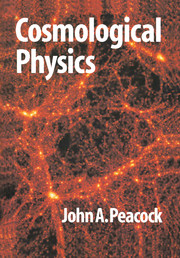Book contents
- Frontmatter
- Contents
- Preface
- Part 1 Gravitation and relativity
- Part 2 Classical cosmology
- 3 The isotropic universe
- 4 Gravitational lensing
- 5 The age and distance scales
- Part 3 Basics of quantum fields
- Part 4 The early universe
- Part 5 Observational cosmology
- Part 6 Galaxy formation and clustering
- Hints for solution of the problems
- Bibliography and references
- Useful numbers and formulae
- Index
4 - Gravitational lensing
Published online by Cambridge University Press: 05 June 2012
- Frontmatter
- Contents
- Preface
- Part 1 Gravitation and relativity
- Part 2 Classical cosmology
- 3 The isotropic universe
- 4 Gravitational lensing
- 5 The age and distance scales
- Part 3 Basics of quantum fields
- Part 4 The early universe
- Part 5 Observational cosmology
- Part 6 Galaxy formation and clustering
- Hints for solution of the problems
- Bibliography and references
- Useful numbers and formulae
- Index
Summary
The previous chapter showed how to understand the propagation of light in a homogeneous universe, allowing the intrinsic properties of cosmologically distant objects to be inferred from the observations we make today. The real universe is of course not perfectly homogeneous, and the propagation of light is influenced by the gravitational fields of collapsed objects. This phenomenon of gravitational lensing (known in French literature by the perhaps more appropriate term gravitational mirages) was first studied by Einstein in 1912 (see Renn, Sauer & Stachel 1997), well before the 1919 eclipse verification of Einstein's formula for light deflection. The Sun can deflect light by angles of order 1 arcsec; over a large enough baseline, this deflection can focus light rays, so that the Sun acts as a gravitational telescope. Over cosmological baselines in particular, the distortions produced by this form of gravitational imaging can be large and significant. In 1979, the discipline of gravitational lensing leapt from theoretical speculation to being an observational tool with the discovery of 0957+561, a quasar split into two images 6 arcsec apart by the gravitation of an intervening galaxy (Walsh, Carswell & Weymann 1979). The subject of gravitational lensing has since developed into one of the major tools of cosmology. It is an invaluable way of probing mass distributions directly, irrespective of whether the matter is dark or visible. For (much) more detail, consult the textbook by Schneider, Ehlers & Falco (1992), or the review by Blandford & Narayan (1992).
- Type
- Chapter
- Information
- Cosmological Physics , pp. 101 - 126Publisher: Cambridge University PressPrint publication year: 1998



